|
I chose this Buddhist temple for two reasons: it was near to where I live in Centreville, and it was a temple that had not been visited before by other students. The Wat Lao Buddhavong temple is in Catlett, VA, on Route 28 South, about 20 minutes drive from Sudley Road in Manassas so it's very easy to find. I called the temple on Friday and a Mr. Somphanh told me to come Saturday, July 30, as it was a special celebration called Boun Khao Pansa, the beginning of Buddhist lent. He told me there would be a lot of food, so I should bring my appetite and my questions!
I placed my shoes outside of the temple and went inside. I had visited Buddhist temples in Asia but the first thing I thought of when I stepped inside was "wow"! Before my visit, I had conjured up a picture of a simple and tranquil temple, but once inside I realized it was far from that. In fact, it reminded me of an outdoor market place, with practically every wall, table and chair adorned with something. It was a visual kaleidoscope of color. I walked toward the front of the temple and saw four single canopied beds. I found out that these beds, as well as the artifacts, represented people who have passed away and the artifacts might have been things they used. Spread across the front of the temple were three extremely large parasols: one pink, one yellow and a multi colored one. There were cushions, tables, lamps, flowers, ornaments, ornamental trees with beads and lights, a table with 50 (I counted) gold Buddha's. You name it, it was there. One half of the hall was filled with books cases while the other half with a glass cabinet full of more Buddha's along with a wide variety of trinkets that were on sale. There were many portraits of Buddha and other religious ornaments and I also saw a heavily beaded silver statue of Ganesh. At the back of the room, near the entrance, was an assortment of chairs and sofas which were filled with devotees sitting and chatting with one another. Looking toward the front of the temple were two very large money trees. Clipped to the trees were hundreds of one, ten and fifty dollar bills. I watched as devotees came and clipped money on the tree. To the front of the main altar a monk was sitting on a cushion reading and reciting a passage from a prayer book. To the left of this monk was the Abbot of Wat Lao Buddhvong, and he was blessing the people who came to him. After this blessing, he tied a piece of thread around their wrist. By doing this, the person takes the blessing of the ceremony away with them.
Before any of the activities started, I decided to sit at the back of the temple, write notes, and spend time looking at what was in the temple and take some photos. Completely covering the upper part of the wall were magnificent paintings telling the story of the Lord Buddha's previous lives. I don't know
who painted them and no one I asked seemed to know either. At the front of the hall was another
painting depicting many monks looking toward a statue of the Buddha. When I first arrived, they were about ten people sitting on the floor,
thirty minutes later; it was very crowded with hardly any space left to sit. Once the blessing started, I noticed that all of the men had moved to the front of the hall directly in front of the monks. The blessing of the food ceremony lasted about fifteen and, from what I could hear; it seemed to be the same prayer being repeated over and over again. During the ceremony, a gentleman came and asked if I had any questions. He told me that they were now reciting the "Three Jewels" of Buddhism. He seemed very pleased that I was holding a copy of the power point presentation showing this (the Buddha, Dharma and the Sangha). You can hear for yourself part of the service:
After the ceremony finished everyone went outside and placed their food offerings into the monk's bowls which had been set up on a table under a canopy. Those who had brought sticky rice (khaonieo) touched the rice to their forehead and placed it inside the monk's bowls. I'm not sure why they did this. There was definitely more food than containers, but someone kept walking up and down the table moving the food and money envelopes into a larger plastic container. After most people had put their offerings into the bowl, they sat around and chatted while others went to the back of the temple to eat. I decided to walk around the garden and follow the delicious cooking smells. There were chicken and meat kabobs with a wide variety of Laotion sauces for dipping. I tried one and spent ten minutes trying to quell the fire in my mouth! Unfortunately, the peacefulness of the garden was suddenly shattered when Loation music came booming through four huge speakers; it was so loud; it vibrated through your chest.
Again, like my visit to the Hindu temple, everyone was very gracious and hospitable and many people often asked if I needed assistance. Perhaps the photos in this report reflect more accurately some of the wonderful things that I saw at the Wat Lao temple. Even though my visit was not as peaceful as I'd expected, it was still a great experience. I've decided to seek this tranquility and peace at the Ekoji Buddhist temple, as so many other students have commented on this aspect of the temple in their reports. |
| Created by Laura Ellen Shulman |
Last updated: December 28, 2007
|
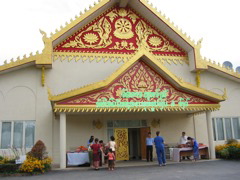 When I arrived, Mr. Somphanh greeted me and he told me the history of
Wat Lao. The Sala Hong Tham (Dharma hall) was dedicated July 3rd, 1993. Prior to moving to Catlett, the
Laotion temple had been situated in Alexandria, but because of zoning restrictions they were forced to
relocate to Catlett. In December 1985, the Lao Buddhist Association purchased the 58 acre property. He explained that the large worship
hall is called a Sala and it is the main area for religious activities. The smaller worship hall is called the Sim. As we walked
toward the main hall, there were Laotion ladies selling, woven baskets, fruit, flowers and monk's robes. Mr. Somphanh explained to me
that attendees would buy these goods to offer to the monks and to the Buddha. Just as the monks are responsible for performing certain
rituals and ensuring the prosperity of the community, the community members must also be responsible to the monks by supporting them with
gifts, food and money. Mr.Somphanh told me that as well as it being the celebration of Lent, there had also been an ordainment of a
resident monk earlier in the morning. The Abbot of Wat Lao is one of the highest ranking Abbots in the U.S, and his name is Phra Achan Maha
Bounmy Kittihammavanno. Mr. Somphanh told me that he had to go and attend to his other duties, but he would find one of the resident
monks to answer my questions.
When I arrived, Mr. Somphanh greeted me and he told me the history of
Wat Lao. The Sala Hong Tham (Dharma hall) was dedicated July 3rd, 1993. Prior to moving to Catlett, the
Laotion temple had been situated in Alexandria, but because of zoning restrictions they were forced to
relocate to Catlett. In December 1985, the Lao Buddhist Association purchased the 58 acre property. He explained that the large worship
hall is called a Sala and it is the main area for religious activities. The smaller worship hall is called the Sim. As we walked
toward the main hall, there were Laotion ladies selling, woven baskets, fruit, flowers and monk's robes. Mr. Somphanh explained to me
that attendees would buy these goods to offer to the monks and to the Buddha. Just as the monks are responsible for performing certain
rituals and ensuring the prosperity of the community, the community members must also be responsible to the monks by supporting them with
gifts, food and money. Mr.Somphanh told me that as well as it being the celebration of Lent, there had also been an ordainment of a
resident monk earlier in the morning. The Abbot of Wat Lao is one of the highest ranking Abbots in the U.S, and his name is Phra Achan Maha
Bounmy Kittihammavanno. Mr. Somphanh told me that he had to go and attend to his other duties, but he would find one of the resident
monks to answer my questions.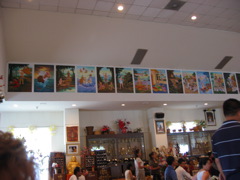
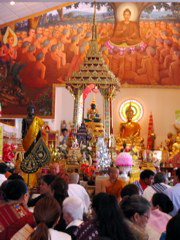
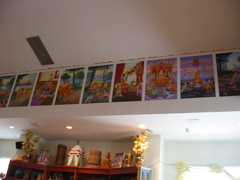
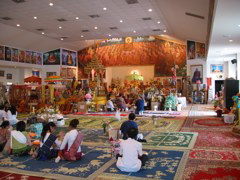
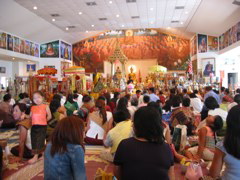 There were more women at the temple than men and they ranged
in age from the very young to the very old. With the exception of a few, they all wore the Laotion national costume called a "sin". This
consists of one piece of material, with an ornate border at the bottom, which is wrapped around and tucked into their waist. The
materials were warm vibrant colors: reds, oranges, purples and greens. The men wore mostly traditional western clothes, but when the
ceremony started they all put on a sash, mainly blue and white check, draped over one shoulder and tied it at the waist. Nearly everyone who
walked into the temple brought food in very ornate containers, but many had exquisite silver bowls with engraving on the side. Each of
these bowls were brimming with food ranging from rice krispie treats, cookies, bananas, apples, bunches of flowers, to sticky rice wrapped
in what I think was a banana leaf. Some carried five pound bags of rice, while others carried the typical Asian Tiffin bowls. These are
bowls stacked one on top of the other with each section holding a different variety of food.
There were more women at the temple than men and they ranged
in age from the very young to the very old. With the exception of a few, they all wore the Laotion national costume called a "sin". This
consists of one piece of material, with an ornate border at the bottom, which is wrapped around and tucked into their waist. The
materials were warm vibrant colors: reds, oranges, purples and greens. The men wore mostly traditional western clothes, but when the
ceremony started they all put on a sash, mainly blue and white check, draped over one shoulder and tied it at the waist. Nearly everyone who
walked into the temple brought food in very ornate containers, but many had exquisite silver bowls with engraving on the side. Each of
these bowls were brimming with food ranging from rice krispie treats, cookies, bananas, apples, bunches of flowers, to sticky rice wrapped
in what I think was a banana leaf. Some carried five pound bags of rice, while others carried the typical Asian Tiffin bowls. These are
bowls stacked one on top of the other with each section holding a different variety of food.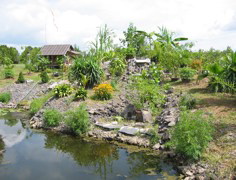 With a chicken kabob in one hand and my notebook in the other, I
headed off in the opposite direction of the music and walked around the rest of the garden. I stopped and talked with a monk who was
sitting near the lake. He told me his name was Khamsay and that he had been born in Vientiane, but during the communist invasion of Laos he
moved to a refugee camp in Thailand. He had been in the US for about ten years and had been at Wat Lao for five months. He told me that
prior to coming to Wat Lao, his life had taken a wrong turn and he had gotten involved with drugs and had spent some time in prison. He was
now trying to turn his life around. I asked him about the other monks sitting near us, four of whom were smoking. I was rather taken aback
by this and Khamsay told me that many monks do smoke but try not to let others see them. After witnessing the other monks smoking and
seeing Khamsay with a cell phone attached to his waist, it came as a surprise to me; I didn't associate smoking and cell phones with monks.
With a chicken kabob in one hand and my notebook in the other, I
headed off in the opposite direction of the music and walked around the rest of the garden. I stopped and talked with a monk who was
sitting near the lake. He told me his name was Khamsay and that he had been born in Vientiane, but during the communist invasion of Laos he
moved to a refugee camp in Thailand. He had been in the US for about ten years and had been at Wat Lao for five months. He told me that
prior to coming to Wat Lao, his life had taken a wrong turn and he had gotten involved with drugs and had spent some time in prison. He was
now trying to turn his life around. I asked him about the other monks sitting near us, four of whom were smoking. I was rather taken aback
by this and Khamsay told me that many monks do smoke but try not to let others see them. After witnessing the other monks smoking and
seeing Khamsay with a cell phone attached to his waist, it came as a surprise to me; I didn't associate smoking and cell phones with monks.